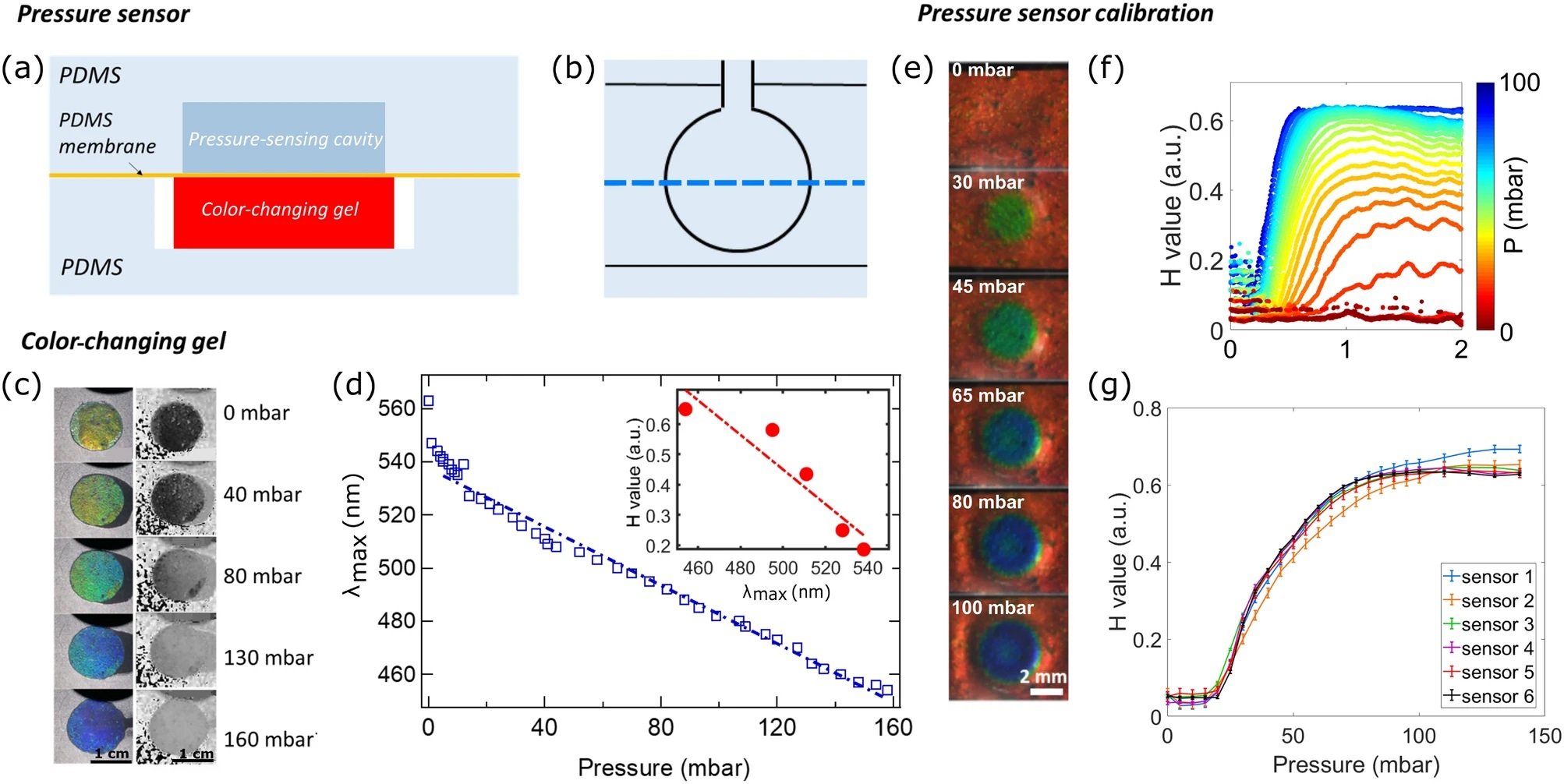
28 Mar A Leap Forward in Microfluidics: The Advent of Color-Switching Hydrogel Pressure Sensors
In the world of microfluidics, where controlling and monitoring the flow of liquids through channels no thicker than a human hair is critical, the development of an microfluidic pressure sensor marks an important advancement. This sensor, born from the collaborative effort of international research team employs color-switching hydrogels to provide a solution to the challenges of microfluidic pressure measurement.
“Here, we demonstrate a fully integrated multiplexed optofluidic pressure sensor, entirely decoupled from the flow path, that enables local pressure measurements along any microfluidic channel without altering its flow geometry.“, the authors explained.
Microfluidic devices have increasingly become the backbone of various applications, from biomedical research and diagnostics to chemical analysis and environmental monitoring. However, one persistent challenge has been the accurate measurement of fluid pressure within these devices without interfering with the fluid’s path or altering the channel’s geometry. Traditional methods often fall short in terms of resolution, non-invasiveness, and ease of use.
A Colorful Solution
Enter the color-switching hydrogel integrated as a pressure sensor. This approach utilizes a soft, mechano-actuated hydrogel that changes color in response to pressure variations. The sensor is designed to sit adjacent to the microfluidic chip, separated by a thin membrane that transmits pressure changes without direct contact with the fluid. This setup ensures the device’s versatility across various fluids and applications, overcoming the limitations of direct fluid interaction and potential alterations to flow geometry.

“General design of the pressure-sensing unit Schematic of the cross-sectional view (a) and the top view (b) of the assembled sensor (not scaled). The dotted line indicates the position of the cross-sectional view. Color-changing hydrogel (c) Color-response of a sample of a free-standing soft photonic gel of 1 cm diameter under uniform applied pressure between a glass slide and a substrate (see Supplementary Fig. S1). The left row indicates the visual response of the gel with RGB color images and the right row with hue value intensity images. (d) Maximum reflected wavelength measured using a spectrometer as a function of applied pressure. The line is a liner adjustment, R2=0.98. Inset: hue value as a function of the reflected wavelength. The line is a guide for the eye. Calibration of the sensing unit. (e) Top view of a sensor (diameter 4 mm, gel layer thickness 140μμm, PDMS membrane thickness 100 μμm) connected to a pressure controller to increase applied static pressure (from 0 to 100 mbar).” Reproduced from Ducloué, L., Haque, M.A., Goral, M. et al. Color-switching hydrogels as integrated microfluidic pressure sensors. Sci Rep 14, 6333 (2024). https://doi.org/10.1038/s41598-024-56140-z. under a CC BY 4.0 DEED Attribution 4.0 International license.
Calibration and Sensitivity
A critical aspect of this sensor’s development involved calibrating its pressure-sensing capabilities. The researchers demonstrated that the microfluidic device could detect pressure changes as small as 20 mbar with a resolution of around 10 mbar. This sensitivity is achieved through the mechanical properties of the hydrogel and the sensor’s design, allowing for fine-tuning to adapt to different measurement ranges and applications.
- Sensor Calibration and Sensitivity: The calibration process revealed the sensor’s ability to detect incremental pressure changes, showcasing its sensitivity. It operates within a pressure range from 20mbar to 140mbar, depending on the mechanical configuration of the sensing unit.
- Multiplexed Integration and Flow Measurement Capabilities: When integrated into a microfluidic channel, the sensor enabled multiplexed pressure measurements, illustrating its adaptability. The experiments demonstrated a linear pressure profile across the channel under steady flow conditions, confirming the sensor’s efficacy in capturing dynamic flow changes.
- Spatial Pressure Mapping: One of the sensor’s standout features is its ability to produce two-dimensional pressure maps, offering unprecedented spatial resolution in microfluidic analysis. This capability could revolutionize the understanding of fluid dynamics in complex channel networks or varying cross-sectional geometries.
- Dynamic Response and Versatility: The sensor’s dynamic response to changing pressures was thoroughly evaluated, indicating its potential for real-time monitoring of transient or turbulent flows in microfluidic systems.
Versatile Applications and Future Perspectives
The implications of this technology extend far beyond mere pressure measurement. The color-switching hydrogel can also create two-dimensional pressure or deformation maps, providing valuable insights into fluid dynamics within microfluidic systems. This capability opens up new avenues for research and development in fields as diverse as organ-on-chip systems, material science, and environmental monitoring.
Furthermore, the sensor’s design ensures compatibility with various types of fluids, offering a non-invasive, easy-to-integrate solution for existing microfluidic setups. This versatility, combined with the straightforward read-out process via a color camera, positions the color-switching hydrogel sensor as a transformative tool in the microfluidic toolkit.
“The use of our pressure sensor is not only limited to microfluidic applications, but it can be plugged into any fluid circuit. For less precise applications a read-out by eye can be imagined and could be useful for example by giving a warning signal above a certain pressure threshold. The spatially resolved pressure measurement opens numerous possibilities for fundamental or industrial research as local pressure measurements in turbulent or complex fluid flows, droplet generation, micro-reactors, cellular growth and deformation, organ-on-chip technology, or medical applications, but also validation of numerical models.“, the authors concluded.
Figures are reproduced from Ducloué, L., Haque, M.A., Goral, M. et al. Color-switching hydrogels as integrated microfluidic pressure sensors. Sci Rep 14, 6333 (2024). https://doi.org/10.1038/s41598-024-56140-z under a CC BY 4.0 DEED Attribution 4.0 International license.
Read the original article: Color-switching hydrogels as integrated microfluidic pressure sensors
For more insights into the world of microfluidics and its burgeoning applications in biomedical research, stay tuned to our blog and explore the limitless possibilities that this technology unfolds. If you need high quality microfluidics chip for your experiments, do not hesitate to contact us.


